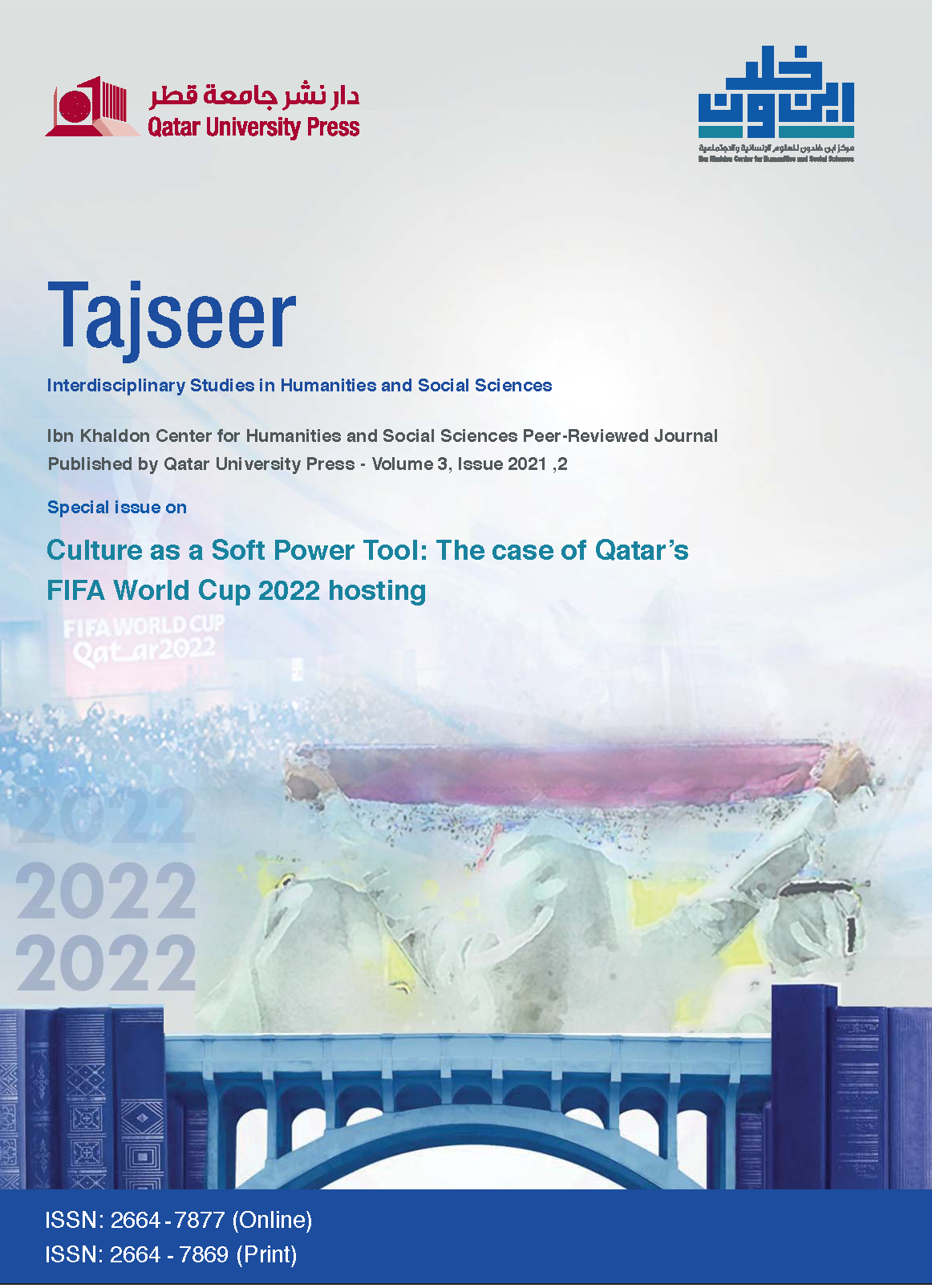The Qatari Culture and Sports Ministry Role in Forming the Country’s Image During the World Cup Organization
Abstract
This article aims at investigating the importance of the institutional role in forming the cultural image for Qatar while organizing the FIFA World Cup 2022. In doing so, the article focusses on the Qatari national’s point of view towards the role played by the Ministry of Culture and Sports and how they invested in sports as a new soft power. This is another type of power Qatar pursued to enhance its international status. The research uses qualitative tools such as interviews and focuses groups and questions How the Qatari intellectuals? How can this approach best serve the event? What is the intellectual’s opinion about the events organized by the ministry of culture? How can it form a cultural image for the state and society? What is the intellectual’s point of view about the youth's role in the events organized by the culture and sports ministry? Moreover, how can they be a part of the cultural branding in the FIFA World Cup 2022 finals? We emphasize three aspects: The Qatari personalities, cultural activities, and human resources. The results reveal disapproval of the ministry involvement in influencing the Qatari personality among many intellectuals. Cultural a positive impact of the activities and events among visitors that help in an ever-active country branding. Moreover, the research underlines the need to enable the citizen’s role, especially among youth, to better organize the upcoming mega sportive event as they represent an asset in forming the aimed positive cultural image.
Metrics
##plugins.themes.bootstrap3.article.details##
World Cup 2022QatarMinistry of Culture and SportsImage of the CountrySoft Power
Amara Mahfoud, Qatar Asian Games: A ‘Modernization’ Project from Above”. Sport in Society. Vol. 8, No, 3 (2005).
Brannagan, Paul Michael & Giulianotti Richard. Soft power and soft disempowerment: Qatar global sport and football’s 2022 World Cup finals. Leisure Studies. Vol. 34, No. 6 (2015).
Grix, Jonathan. Germany and the 2006 FIFA World Cup ‘Image’ leveraging and sports mega-events. Journal of Sport & Tourism. Vol. 17, No. 4 (2012).
Kim, Samuel Seongseop & Alastair M. Morrsion. Change of images of South Korea among foreign tourists after the 2002 FIFA World Cup. Tourism Management. Vol. 26, No. 2 (April 2005).
Lepp Andrew et al. Reimaging a nation: South Africa and the 2010 FIFA World Cup. Journal of Sport & Tourism. Vol. 16, No. 3 (2011).
Ross, Griffin Thomas. National identity, social legacy, and Qatar 2022: the cultural ramifications of FIFA’s first Arab World Cup. Soccer & Society. Vol. 20, No. 7-8 (2019).
References:
ʾAḥmad.Alʿmādī. wāẖrūn. ʾsṭiṭlāʾalqṭryīn walwāfidīn ḥwla ʾstiḍāfat kʾās alʿālam likura alqadam 2022 (in Arabic), Aldwḥa: mʿhad albḥūṯ alʾǧṯimāʿya walʾqtiṣādyya almasḥyya. April 2015.
Edgar, Andrew. Sedgwick, Peter. Mwsūʾa alnẓrya alṯqāfyya lilmafāhīm w almṣṭalẖāt ʾlʾasāsyya. Translated by hanāʾ alqwharī (in Arabic), alqāhira: almarkiz alqwmī liitarjma.2nd ed., 2009.
Gertz, Clifford. Ṯʾwyl al-ṯqāfāt.maqālāt mkhtara (in Arabic), Translated by mūḥammed badwī.bayrūtʾ.markaz dirāsāṯ alwiḥda alʾrabyya.1st ed., 2009.
Giddnes, Anthony. Sassan, Philip. mafāhīm ʾasāsyya fī ʿlm alijtimāʾ (in Arabic ), Translated by mahmūd alḏwadī.qṭr:al -markaz al- ʾrabī lilʾabḥāṯ w drāsa al- siysāt.2018.
Hirz Allāh, Shūsha & Attia, Al Hāj Salem. “The establishment mental image – conceptual and theoretical analysis” (in Arabic). Al - majalla al -jazāiryya lil ʾ amn al- insānī. Volume 5. July 2020.
Ibn Mnẓūr. Lisān Al-ʾarab.(in Arabic), libnān: dār ʾiḥyāʾ al-turāth.c7. 1st ed., 1996.
Jabbār, Ahmad. "The mental image: a Reading in the dimensions of the concept, the points of intersection and the différence between the mental image and the stéréotype and its Relationship to public relations” (in Arabic) Majalla al-rriwāq lil ddirāsāt al ijtimā’yya wal- insānyya. Vol. 7, No. 1 (2020).
Jalabī, ʿlī Abd Al- Razzāq. Al -manāhij Al-kammia wa Al- kayfyya fi ’ilm al ijtimā’ (in Arabic), Egypt: Dār al- ma’rifa al jāmi’yya, 2019.
Kāfūd, Mohammed. Al- ʾadab al- qatarī al- hadith (in Arabic), al-Dawha: Dar qatarī ben Al- Fujāa lil nnašir wa al-ttawzī’, 1982.
Nye, Joseph. al- quwwa al-nāʿima wasīla njāḥ fī al- syāsa al- duwalyya (in Arabic)Translated by mohammed tawfīq al-bijīrmī.al-rryāḍ:al- ʿbīkān lilnnašir.1st ed., 2007.
Sarantakūs. Sotiriūs. al- baḥṯ al-ʾjtimāāʿī ( in Arabic), Translated by šḥḏḏa fāriʿ.al-ddawha: markaz al- ʾrabī lilʾabḥāṯ w drāsa al- siyasāt, 1st ed., 2017.
Smith, Charlotte. mawsūʾa ʿlm al- insān, al- mafāhīm wa al- mūstalḥāt al- inṯurbulujyya. (in Arabic).Translated by muhammed al-jawahirī wa āẖrūn.al-qāhira: al- markaz al-qawmī lil tarjama, 2nd ed., 2009.
***********************************************************************************************
ابن منظور. لسان العرب. لبنان: دار إحياء التراث العربي. ج7. ط1، 1996.
إدجار، أندرو. سيدجويك، بيتر. موسوعة النظرية الثقافية المفاهيم والمصطلحات الأساسية. ترجمة هناء الجوهري.القاهرة: المركز القومي للترجمة ، ط2، 2009.
حرز الله، شوشة وعطية، الحاج سالم. "الصورة الذهنية للمؤسسة – قراءة مفاهيمية نظرية"، المجلة الجزائرية للأمن الإنساني، مجلد 5، ع 2، يوليو 2020.
جبار، أحمد. الصورة الذهنية قراءة في أبعاد المفهوم، نقاط التقاطع والاختلاف بين الصورة الذهنية والنمطية وعلاقاتها بالعلاقات العامة. مجلة الرواق للدراسات الاجتماعية والإنسانية، مجلد 7،ع 1، 2020.
جلبي،علي عبدالرازق.المناهج الكمية والكيفية في علم الاجتماع. مصر: دار المعرفة الجامعية،2019.
سارانتاكوس،سوتيريوس. البحث الاجتماعي. ترجمة شحدة فارع. الدوحة: المركز العربي للأبحاث ودراسة السياسات، ط1، 2017.
سميث،شارلوت. موسوعة علم الإنسان،المفاهيم والمصطلحات الأنثروبولوجية. ترجمة محمد الجواهري وآخرون. القاهرة: المركز القومي للترجمة. ط2، 2009.
العمادي،أحمد. وآخرون. استطلاع آراء القطريين والوافدين حول استضافة كأس العالم لكرة القدم 2022 . الدوحة:معهد البحوث الاجتماعية والاقتصادية المسحية، أبريل 2015.
غيدنر، أنتوني وصاتن،فيليب. مفاهيم أساسية في علم الاجتماع. ترجمة محمود الذوادي. قطر: المركز العربي للأبحاث ودراسة السياسات،2018.
غيرتز،كليفورد. تأويل الثقافات مقالات مختارة. ترجمة محمد بدوي. بيروت: مركز دراسات الوحدة العربية، ط1، 2009.
كافود، محمد. الأدب القطري الحديث. الدوحة : دار قطري بن الفجاءة للنشر والتوزيع، ط2، 1982.
ناي، جوزيف. القوة الناعمة وسيلة نجاح في السياسة الدولية. ترجمة محمد توفيق البجيرمي.الرياض: العبيكان للنشر،ط1، 2007.


